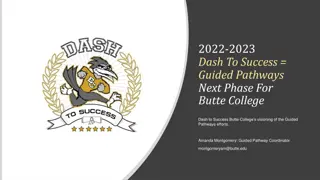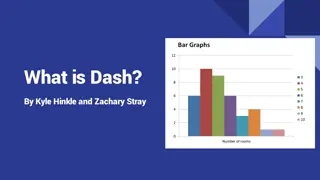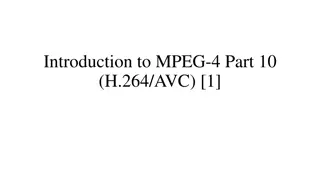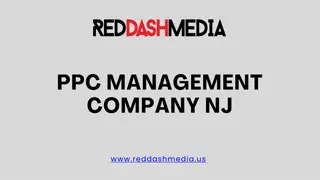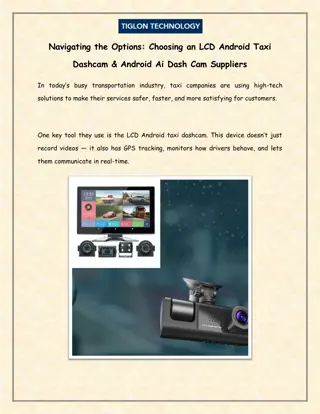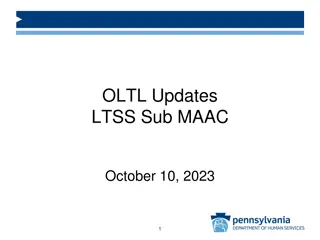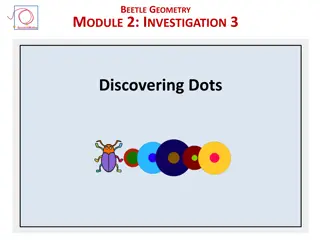MPEG-DASH
MPEG-DASH (Dynamic Adaptive Streaming over HTTP) is a vendor-independent standard ratified by MPEG and ISO. It reduces startup delays, enables bandwidth adaptation, and supports efficient trick mode and DRM schemes. Learn about its key characteristics, relation to standards, and the basic idea behind MPEG-DASH in this comprehensive overview.
Uploaded on Feb 21, 2025 | 0 Views
Download Presentation

Please find below an Image/Link to download the presentation.
The content on the website is provided AS IS for your information and personal use only. It may not be sold, licensed, or shared on other websites without obtaining consent from the author.If you encounter any issues during the download, it is possible that the publisher has removed the file from their server.
You are allowed to download the files provided on this website for personal or commercial use, subject to the condition that they are used lawfully. All files are the property of their respective owners.
The content on the website is provided AS IS for your information and personal use only. It may not be sold, licensed, or shared on other websites without obtaining consent from the author.
E N D
Presentation Transcript
Introduction MPEG-DASH (Dynamic Adaptive Streaming over HTTP, ISO/IEC 23009-1) is a vendor independent, international standard ratified by MPEG and ISO. Previous adaptive streaming technologies such as Apple HLS, Microsoft Smooth Streaming, Adobe HDS, etc. have been released by vendors with limited support of company-independent streaming servers as well as playback clients. As such a vendor-dependent situation is not desired, standardization bodies started a harmonization process, resulting in the ratification of MPEG-DASH in 2012.
Key characteristics reduction of startup delays and buffering/stalls during the video continued adaptation to the bandwidth situation of the client client-based streaming logic enabling highest scalability and flexibility use of existing and cost-effective HTTP-based CDNs, proxies, caches efficient bypassing of NATs and Firewalls by the usage of HTTP common Encryption signaling, delivery & utilization of multiple concurrent DRM schemes from the same file simple splicing and (targeted) ad insertion support for efficient trick mode
Relation to standards MPEG-DASH has been integrated into new standardization efforts, e.g., the HTML5 Media Source Extensions (MSE) enabling the DASH playback via the HTML5 video and audio tag, as well as the HTML5 Encrypted Media Extensions (EME) enabling DRM-protected playback in web browsers. Furthermore, DRM-protection with MPEG-DASH is harmonized across different systems with the MPEG-CENC (Common Encryption) and MPEG- DASH playback on different SmartTV platforms is enabled via the integration in Hybrid broadcast broadband TV (HbbTV 1.5 and HbbTV 2.0). The usage of the MPEG-DASH standard has also been simplified by industry efforts around the DASH Industry Forum and their DASH-AVC/264 recommendations, as well as forward looking approaches such as the DASH-HEVC/265 recommendation on the usage of H.265/HEVC within MPEG-DASH.
MPEG MPEG- -DASH in a Nutshell DASH in a Nutshell The basic idea of MPEG-DASH is as follows chop the media file into segments which can be encoded at different bitrates or spatial resolutions. The segments are provided on a Web server and can be downloaded through HTTP standard compliant GET requests as shown in following slide. the HTTP Server serves three different qualities, i.e., Low, Medium and Best, chopped into segments of equal length. The adaptation to the bitrate or resolution is done on the client side for each segment, e.g., the client can switch to a higher bitrate if bandwidth permits on a per segment basis. This has several advantages because the client knows its capabilities, received throughput and the context of the user best.
Manifest In order to describe the temporal and structural relationships between segments, MPEG-DASH introduced the so-called Media Presentation Description (MPD). The MPD is an XML file that represents the different qualities of the media content and the individual segments of each quality with HTTP Uniform Resource Locators (URLs). This structure provides the binding of the segments to the bitrate (resolution, etc.) among others (e.g., start time, duration of segments). As a consequence, each client will first request the MPD that contains the temporal and structural information for the media content and based on that information it will request the individual segments that fit best for its requirements.
MPD structure - PERIODS The MPEG-DASH Media Presentation Description (MPD) is a hierarchical data model. Each MPD could contain one or more Periods. Each of those Periods contains media components such as video components e.g., different view angles or with different codecs, audio components for different languages or with different types of information (e.g., with director s comments, etc.), subtitle or caption components, etc. Those components have certain characteristics like the bitrate, frame rate, audio-channels, etc. which do not change during one Period. Nevertheless, the client is able to adapt during a Period according to the available bitrates, resolutions, codecs, etc. that are available in a given Period. Furthermore, a Period could separate the content, e.g., for ad insertion, changing the camera angle in a live football game, etc. For example if an ad should only be available in high resolution while the content is available from standard definition to high definition, you would simply introduce an own Period for the ad which contains only the ad content in high definition. After and before this Period, there are other Periods that contain the actual content (e.g., movie) in multiple bitrates and resolutions from standard to high definition.
MPD structure - AdaptationSet Typically media components such as video, audio or subtitles/captions, etc. are arranged in AdaptationSets. Each Period could contain one or more AdaptationSets that enable the grouping of different multimedia components that logically belong together. For example, components with the same codec, language, resolution, audio channel format (e.g., 5.1, stereo) etc. could be within the same AdaptationSet. This mechanism allows the client to eliminate a range of multimedia components that do not fulfill its requirements. A Period could also contain a Subset which enables the restriction of combinations of AdaptationSets and expresses the intention of the creator of the MPD, e.g., allow high definition content only with 5.1 audio channel format.
MPD - Representations An Adaptation Set consists of a set of Representations containing interchangeable versions of the respective content, e.g., different resolutions, bitrates etc. Although one single Representation would be enough to provide a playable stream, multiple Representations give the client the possibility to adapt the media stream to its current network conditions and bandwidth requirements and therefore guarantee smooth playback. Of course, there are also further characteristics beyond the bandwidth describing the different representations and enabling adaptation. Representations may differ in the used codec, the decoding complexity and therefore the necessary CPU resources or the rendering technology, etc.
MPD - Segments Representations are chopped into Segments to enable the switching between individual Representations during playback. Those Segments are described by a URL and in certain cases by an additional byte range if those segments are stored in a bigger, continuous file. The Segments in a Representation usually have the same length in terms of time and are arranged according to the media presentation timeline, which represents the timeline for the synchronization, enabling the smooth switching of Representations during playback. Segments could also have an availability time signaled as wall-clock time from which they are accessible for live streaming scenarios. In contrast to other systems, MPEG-DASH does not restrict the segment length or give advice on the optimal length. This can be chosen depending on the given scenario, e.g., longer Segments allow more efficient compression as Group of Pictures (GOP) could be longer or less network overhead, as each Segment will be requested through HTTP and with each request a certain amount of HTTP overhead is introduced. In contrast, shorter Segments are used for live scenarios as well as for highly variable bandwidth conditions like mobile networks, as they enable faster and flexible switching between individual bitrates.
MPD- Subsegments Segments may also be subdivided into smaller Subsegments which represent a set of smaller access units in the given Segment. In this case, there is a Segment index available in the Segment describing the presentation time range and byte position of the Subsegments, which may be downloaded by the client in advance to generate the appropriate Subsegment requests using HTTP 1.1 byte range requests. During the playback of the content, arbitrary switching between the Representations is not possible at any point in the stream and certain constraints have to be considered. So the Segments are, e.g., not allowed to overlap, dependencies between segments are also not allowed. To enable the switching between Representations, MPEG-DASH introduced Stream Access Points (SAP) on which this is possible. As an example, each Segment typically begins with an IDR-frame (in H.264/AVC) to be able to switch the Representation always after the transmission of one segment.
Segment Referencing Schemes Segment Referencing Schemes Segments are typically referenced through URLs, using HTTP or HTTPs restricted possibly by a byte range. The byte range can be signaled through the attribute range. Segments are part of a Representation, while elements like, BaseURL, SegmentList, SegmentTemplate and SegmentList can add additional information, such as location, availability and further properties. Specifically a Representation shall contain only one option of the following: one or more SegmentList elements one SegmentTemplate one or more BaseURL elements, at most one SegmentBase element and no SegmentTemplate or SegmentList element.
SegmentBase SegmentBase SegmentBase is the most trivial way of referencing segments in the MPEG- DASH standard as it will be used when only one media segment is present per Representation, which will then be referenced through a URL in the BaseURL element. If a Representation should contain more segments, either SegmentList or SegmentTemplate must be used. For example, Representation using SegmentBase could look like this: <Representation mimeType="video/mp4" frameRate="24" bandwidth="1558322" codecs="avc1.4d401f" width="1277" height="544"> <BaseURL>http://cdn.bitmovin.net/bbb/video-1500k.mp4</BaseURL> <SegmentBase indexRange="0-834"/> </Representation>
SegmentList SegmentList The SegmentList contains a list of SegmentURL elements which should be played back by the client in the order at which they occur in the MPD. A SegmentURL element contains a URL to a segment and possibly a byte range. Additionally, an index segment could occur at the beginning of the SegmentList. For example, Representation using SegmentList could look like this: <Representation mimeType="video/mp4" frameRate="24" bandwidth="1558322" codecs="avc1.4d401f" width="1277" height="544"> <SegmentList duration="10"> <Initialization sourceURL="http://cdn.bitmovin.net/bbb/video-1500/init.mp4"/> <SegmentURL media="http://cdn.bitmovin.net/bbb/video-1500/segment-0.m4s"/> <SegmentURL media="http://cdn.bitmovin.net/bbb/video-1500/segment-1.m4s"/> <SegmentURL media="http://cdn.bitmovin.net/bbb/video-1500/segment-2.m4s"/> <SegmentURL media="http://cdn.bitmovin.net/bbb/video-1500/segment-3.m4s"/> <SegmentURL media="http://cdn.bitmovin.net/bbb/video-1500/segment-4.m4s"/> </SegmentList> </Representation>
SegmentTemplate SegmentTemplate The SegmentTemplate element provides a mechanism to construct a list of segments from a given template. This means that specific identifiers will be substituted by dynamic values to create a list of segments. This has several advantages, e.g., SegmentList based MPDs can become very large because each segment needs to be referenced individually, compared with SegmentTemplate, this list could be described by a few lines that indicate how to build a large list of segments. <Representation mimeType="video/mp4" frameRate="24" bandwidth="1558322" codecs="avc1.4d401f" width="1277" height="544"> <SegmentTemplatemedia="http://cdn.bitmovin.net/bbb/video-1500/segment-$Number$.m4s" initialization=http://cdn.bitmovin.net/bbb/video-1500/init.mp4 startNumber="0 timescale="24 duration="48"/> </Representation>
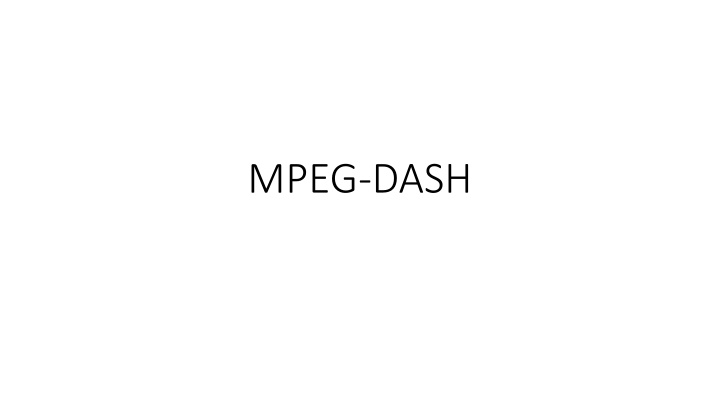

![READ [PDF] Dash diet Cookbook for beginners: 365 days of simple, healthy, low-s](/thumb/2057/read-pdf-dash-diet-cookbook-for-beginners-365-days-of-simple-healthy-low-s.jpg)


